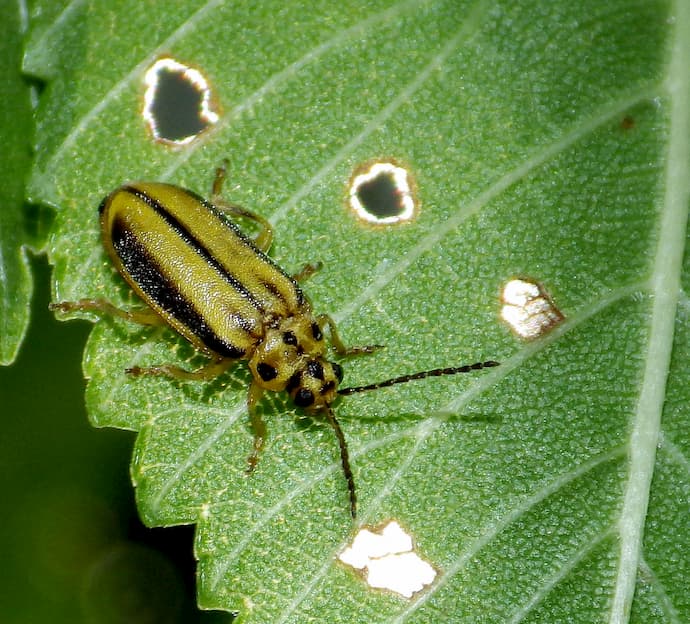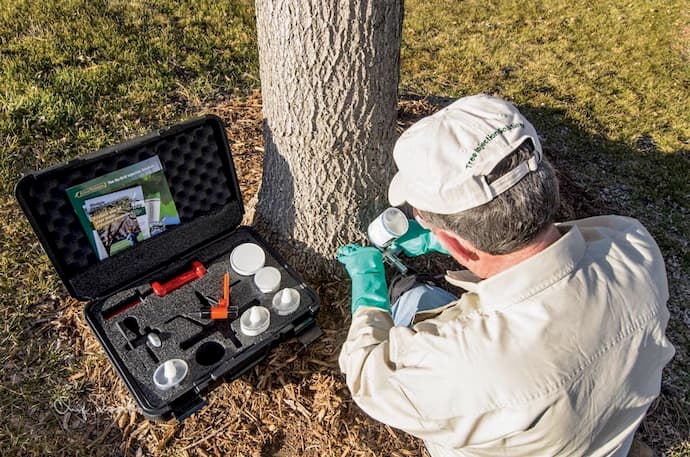If a beautiful elm is adorning your garden, an elm leaf beetle infestation isn’t just an inconvenience, but it can be quite sad and upsetting. These pests are widespread in Australia, so this is not a rare occurrence. If you love having trees, you need to be prepared that eventually, you will have to learn things about taking proper care of them. This includes things like protecting them from different types of dangers, such as pests, whether to trim them yourself or hire professionals, how to prevent dangers from the tree, such as falling branches, etc.
And in case you have an elm tree, amongst other things, you need to learn how to react in the case of an elm leaf beetle infestation. You need to know how you can control the pests properly and in time, with a safe and effective elm leaf beetle treatment so that you don’t have to cut the tree down.
What Are Elm Leaf Beetles?
As the name suggests, elm leaf beetles (Xanthogaleruca luteola) are insects that attack the leaves of elm trees. The number of beetles in a tree, or how heavy the infestation is can depend on the weather. There are some organisms that feed on them, such as insect predators, small parasitic wasps and fungus. However, the best way to keep your tree safe and to manage the infestation is to monitor it closely and find an effective elm leaf beetle treatment promptly once you notice the first signs.

Source: arborscapeservices.com
Elm Leaf Beetle Lifecycle
Elm leaf beetles are green and brown colour, with two stripes. An elm tree infested with them defoliates quite rapidly, and much faster than it should. Furthermore, these 4-6 mm long beetles look for winter shelters inside, which means that they can enter in a nearby home. However, though their invasion is a cause of concern, fortunately, they don’t do any damage nor do they feed on anything inside the home.
The adult beetles then turn yellow-green as they feed, and the female lays one or two dozen yellow eggs. Black larvae hatch from the eggs, and they start chewing the leaves right after. They are fully grown within 3 to 4 weeks, and then they crawl down the trunk and pupate in the cracks of the bark or around the base of the tree, where they transform into their next phase – becoming new adults within two weeks.
More precisely, as the elm tree comes into leaf, these common pests emerge from their winter hibernation and start chewing the leaves, making round holes in the centre of the leaves. Their larvae feed on the green tissue on the underside of the leaves, avoiding the larger leaf veins, and they make a pattern, or “skeletonise” the leaf.
How Do You Treat Elm Leaf Beetle?
If you suspect you have a problem, before taking any steps, it’s very important that a professional identifies the cause of the damaged elm leaves.
One sign that an elm tree is infested with elm leaf beetles are damaged leaves – since they feed on them, leaving holes. The leaves of an elm tree infested by these pests are skeletonised and fall off out of season. Another sign can be discolouration. After you’ve confirmed that this is the case with your elm tree, the best way to take care of it is to proceed with early elm leaf beetle treatment. In fact, this may be crucial for the successful management of the pest.
There are a few ways to treat elm trees, though a combination of methods may be the best solution since unfortunately there isn’t a single action that can definitely improve the health of your tree, or clear it of the pest completely. Since elm leaf beetle infestation can’t be irradicated 100%, but it can be managed, prevention and early reaction are crucial.

Source: turfmagazine.com
Trunk Injection
The most common treatment, that’s also the most effective option, is a trunk injection of the insecticide Imidacloprid. Apart from this, it’s the most environmentally sound option and it’s also safe around pets and children. The treatment is directly injected into the trunk of the tree, after which the tree itself transports the chemical to the leaves. The beetles then ingest the insecticide by feeding on the leaves, and with just a small amount of the leaf, they are killed. This diameter of the trunk must be bigger than 200 mm, for this treatment to be applied.
Spraying
Another option for elm leaf beetle control is canopy spraying. There are different types of foliar sprays. The insecticides used for spraying are highly toxic, which means that they are the less environmentally-friendly option. Foliage sprays are more practical for young trees, because older trees are much larger.
Non-Chemical Options
There is also a non-chemical way for elm leaf beetle control, though it may not be entirely effective for heavy infestations. Non-chemical control banding is a safe option that could break the lifecycle of the elm leaf beetle. It works by trapping the larvae that migrate from the leaves down the trunk, before turning into adult beetles. An adhesive tape is wrapped around the trunk. The strip width should be around 20 cm, but it can vary depending on the weather, which is another reason for close monitoring. If there is a high number of beetles, banding treatments may need to be applied more times during the season in order to be more effective.


















